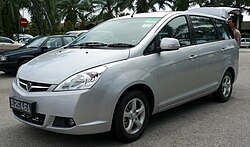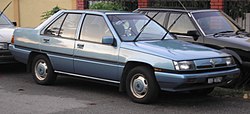First generation
[edit]Saga (1985–1991)
The Proton Saga was launched in September 1985 by Malaysia's then Prime Minister, Mahathir bin Mohamad. Before the production of Proton Saga, a contest was held to choose the name of the first national car, and the name Saga was chosen from the winner of the contest, Ismail Jaafar,[1], a retired military soldier. When asked why he chose this particular name, he replied as "saga" (Abrus precatorius) is a type of soft, fragile but productive seed commonly found in Malaysia, and that the Proton Saga 1.3 litre engine "is as strong as the saga seed".
The first Proton Saga that rolled off the production line was presented to the Malaysian National Museum as a symbol of the beginning of the Malaysian automotive industry. Tun Dr. Mahathir also drove a new Proton Saga with a flag across the Penang Bridge during the opening ceremony of the bridge on 14 September 1985.
Early Saga models were powered by SOHC 8-valve 4-cylinder petrol engines sourced from Mitsubishi, available in both 1.3- and 1.5-litre displacements. Both engines were available with a 5-speed manual transmission, but a 3-speed Mitsubishi Tri-matic automatic was available with the 1.5-liter engine in 1987.
The Saga was originally offered as a 4-door saloon, followed by the addition of a hatchback variant, introduced in 1988 as the Proton Knight and was later know as Saga Aeroback. The Proton Knight was designed for the European market as the hatchback was more popular in United Kingdom.
In 1989, Proton sold the Saga in the United Kingdom with the slogan Japanese Technology, Malaysian Style. Since then, United Kingdom contributes most of Proton's export sales. The Saga name was not used and it was simply known as the Proton 1.3 or 1.5. The UK models reverted to the dashboard used in the Mitsubishi Lancer, complete with HVAC controls not found in the domestic model.
In 1990, the line-up was revised with the introduction of 12-valve Megavalve engines, which increased power ratings to 75 bhp (56 kW) (from the original 70.5 bhp (53 kW) in the former 8-valve (Magma) version[2]) for the 1.3-litre engine, and 90 bhp (67 kW) for the 1.5-litre engine. On domestic models, the Saga also gained the "Megavalve" moniker. Minor exterior modifications included a new grill and wraparound black trim pieces. In addition, rear seat belts and a third brake light were fitted as standard.
A manual, saloon variant of the first facelift Saga. | An automatic, Aeroback variant of the first facelift Saga. |
[edit]Saga Iswara (1992–2008)

The saloon variant of the Proton Saga Iswara.
In 1992, the Saga was given a facelift and its name expanded as Proton Saga Iswara (also known in short as Proton Iswara), after a species of butterfly in Sarawak. Modifications included slimmer headlights, plastic bumpers, side mouldings, coloured door handles, grooved taillight clusters and rear number plate repositioned to the bumper. This particular model is used as taxis in Malaysia and some are converted to NGV. Due to the modification, boot space was reduced by half to accommodate the NGV tank and there are only a few petrol stations by Malaysian oil-giant Petronas in the Klang Valley that sell natural gas, although there are plans underway to increase the number of stations selling it at various locations around Kuala Lumpur.
Models exported to Singapore and the United Kingdom were available with multi-point fuel injection and catalytic converters to meet Euro Iemissions standards. This model was known as the Proton MPi in the United Kingdom. The introduction of the Proton Persona in 1993 replaced the corresponding models in the Saga range in the United Kingdom and this continued until the entire range was replaced in 1996.
In 2001, to regain sales and be competitive with Perodua, Proton introduced a special edition of Saga Iswara Sport based on the Aeroback version which included a new bodykit, metallic rear wing, jewel-effect headlights and Altezza lights, among other changes. It was only available in silver, with a manual transmission and a 1.3-litre engine. The original Saga Iswara Aeroback was still available in a 1.5-litre engine.
While the Iswara Aeroback underwent further modifications in the domestic market to become the Saga LMST in 2003, the saloon variant remained on sale unchanged.
Since the 1990s, the saloon variant of the Proton Saga Iswara dominated as the preferable car model fortaxicabs in Malaysia, as seen with these examples in Kuala Lumpur. | The Proton Saga Iswara Aeroback would later serve as the basis of the re-released Proton Sagas in the 2000s. | The Saga Iswara Sport (introduced 2001), which shares a similar trim design as the Iswara Aeroback. |
[edit]Saga (2003–2008)

The 2007 Proton Saga was the second iteration of the re-released Saga.

The first edition of the Saga LMST (introduced 2003).
As a loose successor to the Saga Iswara Sport, Proton gave the Iswara a new facelift and renamed it back to Saga (or know as Saga LMST by local car community) in 2003. The interior has an entirely new dashboard, door panels and an instrument panel with a digital display consisting of an odometer, a fuel gauge and a temperature gauge. Meanwhile, the exterior received new headlights and taillights and colour-coded bumpers and wing mirrors. Proton retuned the 1.3-litre carburettor engine, and fitted a new exhaust system, increasing its power rating to 83 bhp (62 kW). It is only available with the 5-speed manual transmission.
On March 5, 2007, Proton launched the 50th Merdeka Anniversary Promotion in Malaysia, where the announced new price of the Proton Saga at that time was RM26,999. Advertising campaigns for the Saga Aeroback used a notable rendition of Justin Timberlake's hit singleSexyBack, with the lyrics changed to "AeroBack". The promotion was made as a support to Malaysia's 50th Merdeka Day and also to thank Proton's customers for their support since Proton Saga was first launched,[3] receiving several minor cosmetic changes. The move was also an attempt by Proton to steal potential sales from Perodua's then-forthcoming budget supermini, the Viva. That year, the Proton Saga became the second best selling car behind Perodua MyVi and the best selling saloon car in Malaysia, with over 15,000 orders.
[edit]Second generation (2008–present)
On January 18, 2008, Proton unveiled the successor to the 2007 Saga, which was planned to be phased out in June 2008. Retaining the Saga name, the new car is an indigenous design, essentially based on a stretched Proton Savvy platform. The new model is an in-house design developed in collaboration with Korea's LG CNS and Lotus Engineering. This model enables the Malaysian company play to its strength in the home market i.e. the three-box sedan. The Proton Saga is not planned for U.S. launch but will be sold throughout Southeast Asia, in China, India and Australia
As of February 2008, approximately 23,000 customer bookings had been made for the car since its launch and the corresponding waiting time for delivery during that same period stretched up to 5 months.[6]
[edit]Specifications
The Saga comes in 3 different specifications with the choice of manual or auto transmissions starting from the base specced N model to the fully kitted M model. Aichi Kikai supplies the 5-speed manual while Mitsubishi the 4-speed automatic. The basic N model retails from RM31,500 to the RM39,800 high specced M model. The new Saga would be the cheapest Proton once the RM26,999 original is retired. Proton dubs the new Saga as "The People's Car".
[edit]Engine and performance
The new Saga is powered by the same 1.3-litre Campro engine (which was co-designed with Lotus) that is fitted to entry-level Gen-2s. Besides the 1.3L engine option, the 1.6-liter version is also available as an exclusive engine option for taxi operators[7] before being offered to regular customers.[8] Like other Proton models powered by Proton's own Campro engines, the 1.3-liter engine is rated at 94 hp (70 kW; 95 PS) at 6,000 rpm and 120 N·m (89 lb·ft) at 4,000 rpm, while the 1.6-liter version (not including the Campro CPS engine which is not being used in the Saga) produces 110 hp (82 kW; 110 PS) at 6,500 rpm and 148 N·m (109 lb·ft) at 4,000 rpm. Both engines feature the new Integrated Air-Fuel Module (IAFM) which varies the airflow into the engine to improve efficiency, smoothening out the problematic dip in the torque curve in the lower and middle rev ranges. Its output matches that of a 1.3-litre in the Satria Neo. Power delivery characteristics in both cars are remarkably different. The torque could be felt after 2,500 rpm and all the way to 4,000 rpm. The car feels peppy to drive and acceleration to highway speeds is good. The 5-speed manual from Aichi Kikai is not geared towards the ultimate refinement at cruising speeds, but it does offer a good spread of torque everywhere, not to mention good overtaking power anywhere from 80-120 km/h. Suspension setup consists of MacPherson struts and a stabilizer bar up front with a torsion beam in the rear. Its Lotus designed torsion beam suspension enables it to turn in sharply, hold its stance well through corners, understeering to a sizeable extent. Fuel economy is very good, ranging from approximately 6 L/100 km (47 mpg-imp; 39 mpg-US) for the manual transmission to 6.2 L/100 km (46 mpg-imp; 38 mpg-US) .[9] for the auto and is considerably less when traveling at 80 km/h (50 mph) in fifth. Top speed is around 160 km/h (99 mph) and 0-100 km/h time is about 16 seconds. The electrical system has also been updated with coil-on-plugs instead of the traditional ignition cable system, eliminating power loss.
[edit]Cabin and interior
It has boot space of (413 l (14.6 cu ft)). [5] Because the new Saga, like its predecessor, is expected to be standard among Malaysian taxicab operators,[7] the car is designed to accommodate a compressed natural gas tank without considerably restricting boot space. There is ample room for 5 adults and the interior is bigger than the old Saga. Top-of-the-line version have a set of 14-inch tyres and ventilated disk brakes for added traction, providing the car with strong braking force and better road holding. Airbag is also fitted to the medium-specced models onward.
Since the official launch of the second generation Proton Saga in January 2008, the car has won 3 major automobile awards. Autocar Asean, the Malaysian edition of the longest running car magazine in history has awarded the new Saga "Winner of the Small Sedan/ Hatchback Category" for 2008. Shortly after that, the car was voted as the "Best People's Car" at the Asian Auto - VCA Auto Industry Award 2008[10]. In November the same year, the new Saga won yet another major Malaysian automobile accolade when it was declared the "Winner of the Entry Level Car Category" under the New Straits Times/ Maybank Car of the Year Awards for 2008.













